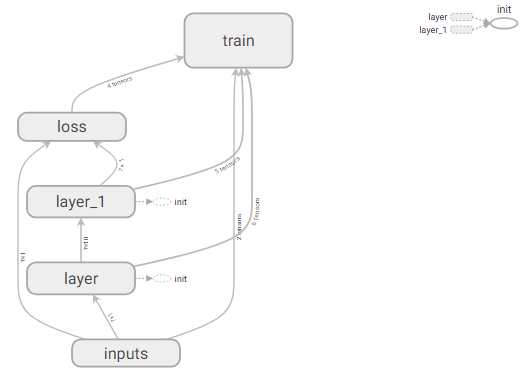# 创建神经网络, 使用tensorboard 展示graph import tensorflow as tf import numpy as np import matplotlib.pyplot as plt # 若没有 pip install matplotlib # 定义一个神经层 def add_layer(inputs, in_size, out_size, activation_function=None): #add one more layer and return the output of this layer with tf.name_scope('layer'): with tf.name_scope('Weights'): Weights = tf.Variable(tf.random_normal([in_size, out_size]),name='W') with tf.name_scope('biases'): biases = tf.Variable(tf.zeros([1, out_size]) + 0.1,name='b') with tf.name_scope('Wx_plus_b'): Wx_plus_b = tf.matmul(inputs, Weights) + biases if activation_function is None: outputs = Wx_plus_b else: outputs = activation_function(Wx_plus_b)### return outputs #make up some real data x_data = np.linspace(-1, 1, 300)[:, np.newaxis] # x_data值为-1到1之间,有300个单位(例子),再加一个维度newaxis,即300行*newaxis列 noise = np.random.normal(0, 0.05, x_data.shape) # 均值为0.方差为0.05,格式和x_data一样 y_data = np.square(x_data) - 0.5 + noise #define placeholder for inputs to network with tf.name_scope('inputs'): xs = tf.placeholder(tf.float32, [None, 1],name='x_input1') # none表示无论给多少个例子都行 ys = tf.placeholder(tf.float32, [None, 1],name='y_input1') # add hidden layer l1 = add_layer(xs, 1, 10, activation_function=tf.nn.relu) # add output layer prediction = add_layer(l1, 10, 1, activation_function=None) #the error between prediction and real data with tf.name_scope('loss'): loss = tf.reduce_mean( tf.reduce_sum(tf.square(ys - prediction), reduction_indices=[1])) # 对每个例子进行求和并取平均值 reduction_indices=[1]指按行求和 with tf.name_scope('train'): train_step = tf.train.GradientDescentOptimizer(0.1).minimize(loss) # 以0.1的学习效率对误差进行更正和提升 #两种初始化的方式 #init = tf.initialize_all_variables() init = tf.global_variables_initializer() sess = tf.Session() sess.run(init) #把整个框架加载到一个文件中去,再从文件中加载出来放到浏览器中查看 #writer=tf.train.SummaryWriter("logs/",sess.graph) #首先找到tensorboard.exe的路径并进入c:AnacondaScripts,执行tensorboard.exe --logdir=代码生成的图像的路径(不能带中文) writer=tf.summary.FileWriter("../../logs/",sess.graph) fig = plt.figure() ax = fig.add_subplot(1, 1, 1) ax.scatter(x_data, y_data) plt.ion() plt.show() #show()是一次性的展示,为了使连续的展示,加入plt.ion() for i in range(1000): sess.run(train_step, feed_dict={xs: x_data, ys: y_data}) if i % 50 == 0: # to see the step improment 显示实际点的数据 # print(sess.run(loss,feed_dict = {xs:x_data,ys:y_data})) try: # 每次划线前抹除上一条线,抹除lines的第一条线,由于lines只有一条线,则为lines[0],第一次没有线 ax.lines.remove(lines[0]) except Exception: pass # 显示预测数据 prediction_value = sess.run(prediction, feed_dict={xs: x_data}) # 存储 prediction_value 的值 lines = ax.plot(x_data, prediction_value, 'r-', lw=5) # 用红色的线画,且宽度为5 # 停止0.1秒后再画下一条线 plt.pause(0.1)
生成的tensorboard的graph:
